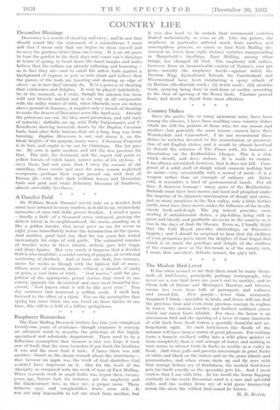Country Dishes Since the poets, like so many epicurean mice,
have been among the cheeses, I have been recalling some country dishes which are still the portion of those who, for one reason and another--but generally the same reason—cannot have their Wensleydale and Camembert. I do not recommend these dishes to societies devoted to the resuscitation or preserva- tion of old English dishes, and it would be almost heretical to disturb the columns of The Times with, for instance, a dissertation on the Bedfordshire Clanger. This is a dish which should, and does, endure. It' is made to endure. I am always astonished, however, that it does not kill. Com- posed of a solid shell of dough which conceals nothing but an onion—very occasionally with a morsel of meat—it is a weapon rather than an example of culinary art. Eaten cold, it resembles a kind of gastronomical bomb. For all that, it deserves homage : many acres of the Bedfordshire flatlands must have been mown and hoed and ploughed under the impetus of its dynamic combination of dough and onion, just as many meadows in the Nen valley, only a little farther north, must have been mown under the influence of the locally classic hock-and-dough. The pig indeed provides some sterling if unfashionable dishes, a pig-killing being still as great and bloody and profitable an event in the country as it was in the days of Jude the Obscure. Even so, I hardly think that the Cafe Royal provides chitterlings, or Frascati's faggots ; and I should be surprised to hear that the children of even penurious poets know the delights of that frugal dish which is as much the privilege and delight of the children of the country poor as the fox-brush is of the county rich. I mean that succulent, delicate morsel, the pig's tail.










































 Previous page
Previous page